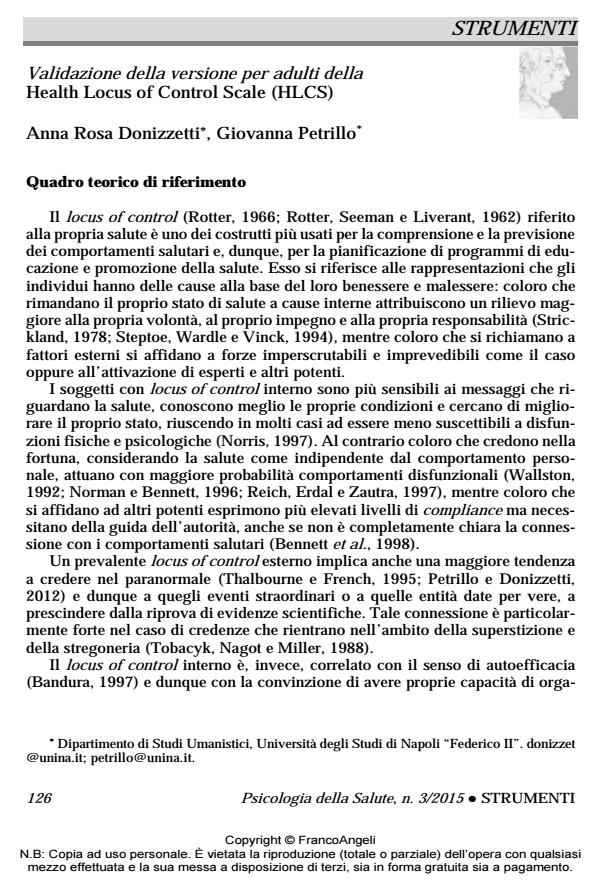Validazione della versione per adulti della Health Locus of Control Scale (HLCS)
Titolo Rivista PSICOLOGIA DELLA SALUTE
Autori/Curatori Anna Rosa Donizzetti, Giovanna Petrillo
Anno di pubblicazione 2015 Fascicolo 2015/3
Lingua Italiano Numero pagine 17 P. 126-142 Dimensione file 220 KB
DOI 10.3280/PDS2015-003007
Il DOI è il codice a barre della proprietà intellettuale: per saperne di più
clicca qui
Qui sotto puoi vedere in anteprima la prima pagina di questo articolo.
Se questo articolo ti interessa, lo puoi acquistare (e scaricare in formato pdf) seguendo le facili indicazioni per acquistare il download credit. Acquista Download Credits per scaricare questo Articolo in formato PDF

FrancoAngeli è membro della Publishers International Linking Association, Inc (PILA)associazione indipendente e non profit per facilitare (attraverso i servizi tecnologici implementati da CrossRef.org) l’accesso degli studiosi ai contenuti digitali nelle pubblicazioni professionali e scientifiche
È ormai riconosciuto che il locus of control della salute è un costrutto importante per la comprensione e la previsione dei comportamenti salutari, ma le proprietà psicometriche degli strumenti di rilevazione disponibili non sono pienamente accertate. Obiettivo di questo studio è stato quello di verificare le proprietà psicometriche dell’Health Locus of Control Scale (HLCS) per adolescenti di Donizzetti e Petrillo (2011) in una popolazione di adulti. I 922 partecipanti, equamente distribuiti per sesso (50.2% maschi), hanno un’età media di 52.2 anni (DS = 20.20). Le analisi fattoriali confermative hanno accertato la struttura a tre dimensioni, le analisi correlazionali ne hanno dimostrato la validità convergente e discriminante e le analisi confermative multi-gruppo ne hanno confermat l’invarianza per genere. L’HLCS, che nella versione per adulti consta di 13 item, si è confermata uno strumento valido ed affidabile. Di facile somministrazione, esso è utilizzabile con finalità di ricerca e di intervento per la rilevazione delle credenze circa il controllo della propria salute fisica anche in popolazioni di adulti.
Parole chiave:Locus of control della salute; HLCS; Validazione di Scale di misura; Adulti.
- Paranormal Health Beliefs: Relations Between Social Dominance Orientation and Mental Illness Donizzetti Anna Rosa, in The Open Psychology Journal /2018 pp.35
DOI: 10.2174/1874350101811010035 - The “Land of Fires” Toxic Waste Scandal and Its Effect on Consumer Food Choices Luigi Cembalo, Daniela Caso, Valentina Carfora, Francesco Caracciolo, Alessia Lombardi, Gianni Cicia, in International Journal of Environmental Research and Public Health /2019 pp.165
DOI: 10.3390/ijerph16010165 - University Student Mental Well-Being during COVID-19 Outbreak: What Are the Relationships between Information Seeking, Perceived Risk and Personal Resources Related to the Academic Context? Vincenza Capone, Daniela Caso, Anna Rosa Donizzetti, Fortuna Procentese, in Sustainability /2020 pp.7039
DOI: 10.3390/su12177039 - The Relation Between Maternal Locus of Control And Coping Styles of Pediatric Leukemia Patients During Treatment Concetta Polizzi, Giovanna Perricone, Valentina Fontana, Paolo D'Angelo, Momcilo Jankovic, Francesca Nichelli, Calogero Taormina, Sofia Burgio, in Pediatric Reports /2020 pp.7998
DOI: 10.4081/pr.2020.7998 - Behind the Scenes of COVID-19 Vaccine Hesitancy: Psychological Predictors in an Italian Community Sample Sofia Tagini, Agostino Brugnera, Roberta Ferrucci, Alberto Priori, Angelo Compare, Laura Parolin, Gabriella Pravettoni, Vincenzo Silani, Barbara Poletti, in Vaccines /2022 pp.1158
DOI: 10.3390/vaccines10071158 - Validation of the Paranormal Health Beliefs Scale for adults Anna Rosa Donizzetti, Giovanna Petrillo, in Health Psychology Open 2055102917748460/2017
DOI: 10.1177/2055102917748460 - Exploring emotions in dialog between health provider, parent and child. An observational study in pediatric primary care Francesca Dicé, Pasquale Dolce, Assunta Maiello, Maria Francesca Freda, in Pratiques Psychologiques /2020 pp.69
DOI: 10.1016/j.prps.2018.12.001 - Ageism in an Aging Society: The Role of Knowledge, Anxiety about Aging, and Stereotypes in Young People and Adults Anna Rosa Donizzetti, in International Journal of Environmental Research and Public Health /2019 pp.1329
DOI: 10.3390/ijerph16081329 - Attachment, Personality and Locus of Control: Psychological Determinants of Risk Perception and Preventive Behaviors for COVID-19 Sofia Tagini, Agostino Brugnera, Roberta Ferrucci, Ketti Mazzocco, Luca Pievani, Alberto Priori, Nicola Ticozzi, Angelo Compare, Vincenzo Silani, Gabriella Pravettoni, Barbara Poletti, in Frontiers in Psychology 634012/2021
DOI: 10.3389/fpsyg.2021.634012 - Facing the pandemic lockdown questionnaire - FPLQ: A brief tool to assess individual differences in front of pandemic experience Andrea Baroncelli, Lucrezia Tomberli, MariaGiulia Taddei, Enrica Ciucci, in Current Psychology /2023 pp.30635
DOI: 10.1007/s12144-022-02701-2
Anna Rosa Donizzetti, Giovanna Petrillo, Validazione della versione per adulti della Health Locus of Control Scale (HLCS) in "PSICOLOGIA DELLA SALUTE" 3/2015, pp 126-142, DOI: 10.3280/PDS2015-003007